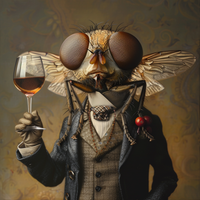Fruit Flies and Wine: A Serendipitous Symbiosis
Posted by Matteo Lahm on 24th Apr 2024
The tantalizing aroma of your favorite wine may owe a debt of gratitude to an unexpected source: fruit flies. However, the role these tiny creatures play is more coincidental than direct. Research led by Dr. Mat Goddard, published in the scientific journal Ecology Letters, suggests that fruit flies play a pivotal role in the spread of yeast, which in turn contributes to the aromatic compounds in wine.
Before proceeding, let's be clear, these flies are not the sommeliers of the insect world, but rather the unwitting transporters of yeast. So, if you are on a social media thread and somebody comments that they heard fruit flies in your fermenter are good for your wine, don’t believe them. However, if you are working from fresh grapes and utilizing spontaneous fermentation, your wine would not ferment properly, without the fruit fly.
The yeast responsible for wine fermentation, Saccharomyces cerevisiae, has a unique survival strategy. It thrives on ripe fruit, but so do many other organisms. To outsmart its competition, S. cerevisiae uses alcoholic fermentation, a process that creates heat and alcohol, making the environment less inviting for other organisms, especially bacteria.
But the yeast faces a challenge: ripe fruits are seasonal and spread far apart. How does the non-mobile yeast reach its next meal? The answer lies in their evolutionary strategy of producing aromatic compounds that attract fruit flies. These insects are drawn to fermenting fruit where yeasts are growing, and conveniently, they lay their eggs there.
The study demonstrated that S. cerevisiae was being carried by 100 times more flies than you’d expect if the flies were randomly recruiting fungi from the environment. This indicates that the yeast's aromatic compounds are indeed successful in luring fruit flies. This mutualistic symbiosis benefits both parties: the yeast gets a ride to its next food source, and the fruit flies find a fertile environment for their eggs.
In this respect, the fruit fly is to yeast what pollen is to the bee. The fruit fly plays no active role in fermentation itself. It is purely serendipitous, helping the yeast spread much like bees help pollen spread. This might explain why vineyards often leave bunches of grapes they remove from the vines right in the field.
However, let's debunk a common myth: the idea that fruit flies invading your must improves the flavor is completely unfounded. In fact, you want to keep these critters as far away from your fermentation vessel as possible. Their role in the wine production process is played out long before the grapes are harvested. Always practice due diligence and keep your fermenter covered. If there are fruit flies in the vicinity, they will definitely find their way into your must. They find the smell irresistible, like Odysseus and the mythical Sirens.
In conclusion, while fruit flies play a significant, albeit accidental, role in the early stages of wine production, their presence during fermentation is not only unnecessary but also undesirable. The next time you're enjoying the aroma of your favorite wine, remember the tiny fruit flies. Without their early-stage assistance, your wine might not smell as sweet. But remember, they've played their part and are not invited to the fermentation party.

